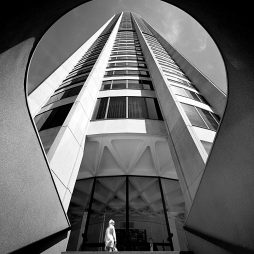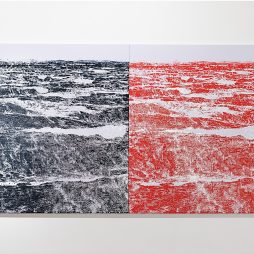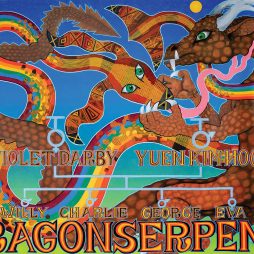Frida Kahlo | In her own image
Frida Kahlo: In her own image offers rich insight into the life and persona of one of the twentieth century’s most recognised painters. Exclusive to Bendigo Art Gallery, the expansive display of personal effects and artworks show Kahlo as an enduring icon and a woman ahead of her time.
Frida Kahlo (1907-1954) is perhaps best known for her intimate self-portraits exploring pain, love, and loss, replete with potent symbolism and social commentary. She gained global popularity for her defiant style that challenged prescribed gender norms and embraced the pleasure of self-adornment. Per the curatorial premise, Frida Kahlo enriches viewers with a wealth of materials illuminating the artist’s life and uniquely crafted image.
The exhibition is curated by Mexican-born fashion curator, Circe Henestrosa, historian Gannit Ankori, and Bendigo Art Gallery managing curator Lauren Ellis. It includes personal items from Mexico’s Museo Frida Kahlo, never seen before in Australia. It begins by contextualising Kahlo’s middle-class upbringing before expanding on her modernist self-taught artistry, communist activism, fame, challenging disabilities and iconic aesthetic. Across multiple galleries, select artworks are curated alongside photographs, written material and memorabilia. Spectacular examples of Kahlo’s clothing and intimate talismanic objects, including jewellery and medical items, bring audiences closer to her.
Kahlo’s maternal Indigenous Purépecha heritage (represented in dress evident in family photographs) and the air of cultural hybridity in post-1910 revolution Mexico, informed her combining of Tehuana, European and other dress styles. Childhood polio and a tragic bus accident when she was eighteen left her with life-long pain and injuries. The exhibition’s extensive selection of her boldly coloured dresses and flowing skirts shows how they helped her conceal these physical aspects while cultivating dynamic sartorial expression. Kahlo’s orthopaedic corsets, decorated medical cast, and prosthetic leg are also displayed. Their inclusion acknowledges the reality of Kahlo’s disabilities and their creative, generative significance, given the repeated references to her physical and psychological health in her art.
The exhibition’s extensive selection of photographs highlights the medium’s role in shaping Kahlo’s unique comportment and artistry. As a child she provided technical assistance to her photographer father. Her keen consideration of the discerning eye of the viewer is evident in early photo-portraits and rare films of her, just as astute self-awareness of poise and pose is so apparent in her art.
Captivating, coloured portraits by acclaimed photographers and photojournalists depict the artist’s grandeur. Her striking fashion, flower-entwined hair, painted nails, and gold jewellery frame her signature returned gaze assertively meeting that of the viewer. Kahlo famously referred to herself as “the great concealer.” By constructing the persona of Frida, the celebrity artist, she could obscure her more intimate side.
Small black and white photographs taken by Kahlo’s family, friends and lovers reveal other personal qualities and interests, including passion and care for her garden and animals, and individually crafted home. Images of Kahlo ill in bed indicate her determination to document her condition. Photographs of her wearing masculine attire confirm her provocation of strict gender expectations and spectrum of self-expression. One photograph included is a rare image with her hair down, taken after a significant operation. She is wearing black pyjamas and leaning back with a cigarette in hand. In pain, she still exudes undeniable sensuality.
Fascinating written materials reveal Kahlo’s strong social convictions as a member of Mexico’s post-revolution intelligentsia, and artistic successes and challenges. Audiences learn that although sceptical of capitalist culture, Kahlo gained prominence exhibiting in America often, although only once in Paris. She was claimed as a surrealist, which rightfully aggravated her sense of idiosyncratic, self-initiated aesthetic. Nevertheless, her international recognition saw her become an important promoter of Mexican culture and increased her political activism. Personal texts confirm her tumultuous marriage with artist Diego Rivera. He was her artistic advocate yet romantically betrayed her. She, though, also had many affairs with men and women alike while still affording him great admiration.
Kahlo’s art and home décor drew on Catholicism (the exhibition includes several tiny votive panels she collected), reflecting her interest in the power of iconography and pathos (over dogma). Indigenous folk and pre-Columbian imagery are also a constant in her extended artistry, signifying her ideology of deep Mexican identification. Yet Kahlo is a synecdoche for fraught nationalism to which she inadvertently contributed. Acknowledging this opens more nuanced evaluations through indigenous perspectives on her evolving legacy.
As Kahlo’s star rose, her health declined, leading to her passing at age forty-seven. The spectre of death loomed large during her life. Yet, through it, she boldly reached for the splendid. Kahlo’s Self-Portrait with Thorn Necklace and Hummingbird, 1940, concludes the exhibition beautifully. It is an exquisite, symbolically laden exemplar of an artist prepared to express personal pains with creative gravitas and defiance.
Concern as to dark fetishisation of the memento-mori residue of an artist’s life exists with exhibits such as this. However, in this instance the interest is essentially one of reverence and inspiration for audiences, which Frida Kahlo eloquently and engrossingly cultivates. For women, LGBTQIA+ communities, and those navigating cultural identity, and visible and non-visible disabilities, the exhibition champions the potential to shape ourselves in an image of our own making, as Kahlo so formidably shaped hers.
















